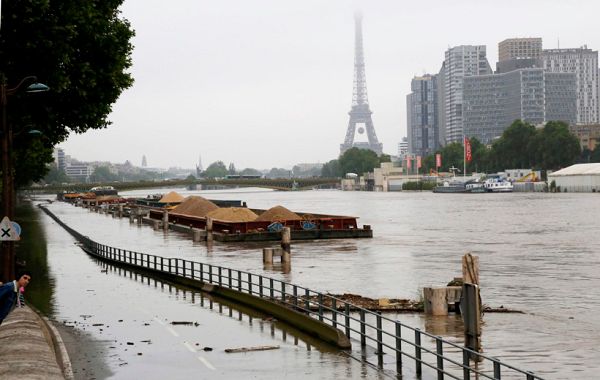
Despite the rhetoric, the US can’t pull out of Paris pact before Nov 4, 2020
The world today is “locked” in more ways than one. Brutal inequality, dreadful terrorism, unashamed threats on territorial claims and bullying on nuclear missile attacks have all locked our civilisation in a spiral trajectory of global hazards without any sign of slowing down.
Recent climate studies by Nature Climate Change, published on July 31, note that the world has also “locked” itself in a way that has never happened in human history of more than 800,000 years.
It reveals the steady and steep rise of warming of the Earth’s temperature due to human induced green house gases (GHGs) that have already been emitted in the past, thereby locking the fate of the Earth due to climate change. As per the study, there is only one per cent chance, irrespective of the global action, to limit the temperature rise at 1.5 degrees Celsius — the lower limit of the range of warming agreed to in the 2015 Paris accord.
Research published in May 2017 in the journal Geophysical Research Letters also stated that the Earth’s warming now is already on the way to touch 1.5 deg C and it will, in all certainty, cross that figure in nine years from now, whatever kind of efforts we make.
As for the upper warming limit of 2 degrees Celsius pledged in the Paris agreement, many scientists, including those who wrote the fifth assessment reports of the Intergovernmental Panel on Climate Change (IPCC), warn that crossing of 2 degrees Celsius warming would be catastrophic to humanity. In reality, this upper limit is called the death zone and may trigger “runaway” climate change, leading to globally disastrous and uncontrolled chain of extreme events that would signal the beginning of extinction of life on Earth.
The European Commission’s Joint Research Centre this month published a study, based on one by Lancet Planetary Health, that hinted at the beginning of the global catastrophe. It said that the deaths caused by extreme weather in Europe could rise from 3,000 a year between 1981 and 2010 to 50 times that figure — 152,000 a year — between 2071 and 2100. Europeans have the best social health system in the world to protect themselves and those numbers would look minuscule if we think of what would happen in poor developing countries.
With the rise in temperature, one of the scenarios is related to melting of glaciers, permafrost — Arctic and the Antarctic. The ice-melt would result in releasing massive emissions of GHGs like CO2 and methane trapped for centuries under the ice which would warm the planet more and cause more melt, thus “locking” the Earth in a vicious cycle. Last week a study published by the Geological Society of London revealed that there are 91 volcanoes, not known before, buried under the ice in Antarctica which, if exposed due to ice melt, can become live and belch out massive amounts of GHGs and warm the planet at unprecedented speed — thawing more ice. Less ice also means less white surface to reflect the sunlight and heat back into space, thereby causing more warming.
As the world’s oceans warm, not only is marine life at risk of extinction, but the massive stores of dissolved carbon dioxide may be quick to bubble out into the atmosphere and further amplify temperature rise, thus continuing the cycle towards runaway climate change.
This month’s real “breaking news” was of the breaking away of large icebergs — three times the size of Mauritius — from Antarctica’s fourth-largest ice shelf. The icebergs, being a floating mass, do not raise the sea level. However, Antarctica’s glaciers, which are held in place by the walls of the icebergs would now start emptying into the sea, which would start raising the sea-level.
The more stunning possibility that has become a subject of hot debate in the realms of the science of oceanography is the disruption in oceanic currents. The debate revolves around the scenario that the melting ice from the poles may cause the huge ocean currents — called heat conveyor belts, keeping the northern countries warm and causing healthy rain patterns, including monsoon rains — to either slow down or stop or reverse. The consequences are not well established but this could well be the “black hole” of uncertainties. Some scientists have already observed the slowing down of the ocean currents.
To top it all, on August 4, the US served notice on the United Nations that it “intends to exercise its right to withdraw from the (Paris Climate) Agreement”. This has created a situation that would “slow down the conveyor belts of diplomacy”, according to a climate negotiator from a small island country.
The Paris Climate Agreement, interestingly, entered into force on November 4, 2016. Under Article 28 of that agreement, withdrawal by a country that has ratified the pact — which the US did when Barack Obama was the President — is possible only after three years from the date of entry into force. Further, such withdrawal would be effective “upon expiry of one year from the date of receipt of the notification of the withdrawal”. Thus, the earliest US withdrawal can take place only on November 4, 2020, around the time when its next President would be declared.
Is President Donald Trump himself “locked” in Article 28 or is the world “locked” in Trumpian ambiguity? Whatever the case, the key to unlock the climate puzzle may need a flood of positive runaway efforts on a planetary scale.
(Rajendra Shende is Chairman, TERRE Policy Centre, an IIT alumnus and former director of the UNEP. The views expressed are personal. He can be contacted at shende.rajendra@gmail.com)
—IANS


